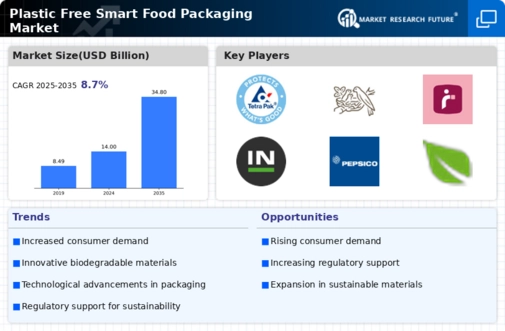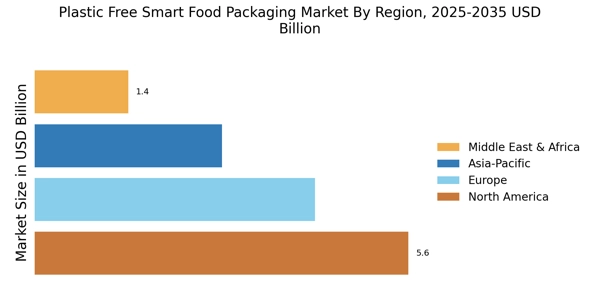Corporate Sustainability Initiatives
Many companies are increasingly adopting corporate sustainability initiatives, which appear to be a driving force behind the Plastic Free Smart Food Packaging Market. Organizations are recognizing the importance of sustainability not only for compliance but also for enhancing brand reputation. By committing to plastic-free packaging, companies can differentiate themselves in a competitive market. Recent surveys indicate that over 60% of businesses plan to invest in sustainable packaging solutions within the next two years. This commitment to sustainability is likely to accelerate the transition towards plastic-free options, thereby benefiting the Plastic Free Smart Food Packaging Market.
Technological Advancements in Packaging
Innovations in packaging technology seem to play a crucial role in the evolution of the Plastic Free Smart Food Packaging Market. The integration of smart technology, such as sensors and QR codes, enhances the functionality of packaging while ensuring it remains environmentally friendly. For instance, smart packaging can provide real-time information about product freshness and safety, which is increasingly valued by consumers. The market for smart packaging is projected to grow at a compound annual growth rate of 7.5% over the next five years, indicating a strong potential for the Plastic Free Smart Food Packaging Market to leverage these advancements.
Consumer Demand for Sustainable Solutions
The increasing consumer awareness regarding environmental issues appears to drive the Plastic Free Smart Food Packaging Market. As consumers become more conscious of their ecological footprint, they actively seek products that align with their values. This shift in consumer behavior has led to a notable rise in demand for sustainable packaging solutions. According to recent data, approximately 70% of consumers express a preference for brands that utilize eco-friendly packaging. This trend suggests that companies in the food sector are likely to invest in plastic-free alternatives to meet consumer expectations, thereby propelling the growth of the Plastic Free Smart Food Packaging Market.
Rising Health Consciousness Among Consumers
The growing health consciousness among consumers seems to be influencing their purchasing decisions, particularly in the food sector. As individuals become more aware of the potential health risks associated with plastic packaging, there is a noticeable shift towards plastic-free alternatives. Research indicates that nearly 65% of consumers are concerned about the impact of plastic on food safety and quality. This heightened awareness is driving food manufacturers to explore innovative packaging solutions that prioritize health and safety. Consequently, the Plastic Free Smart Food Packaging Market is likely to experience growth as companies respond to these consumer preferences.
Regulatory Pressure for Environmental Compliance
Regulatory frameworks aimed at reducing plastic waste are likely to influence the Plastic Free Smart Food Packaging Market significantly. Governments across various regions are implementing stringent regulations to limit the use of single-use plastics, thereby encouraging companies to adopt sustainable packaging solutions. For example, several countries have introduced bans on plastic bags and straws, which has prompted food manufacturers to explore alternative packaging options. This regulatory pressure not only fosters innovation but also creates a favorable environment for the growth of the Plastic Free Smart Food Packaging Market, as businesses strive to comply with new standards.


















Leave a Comment